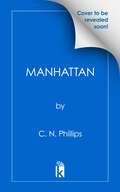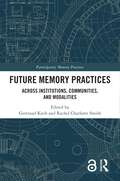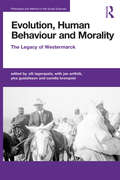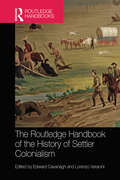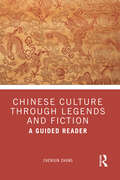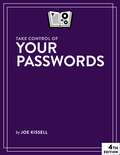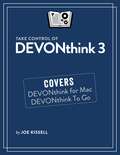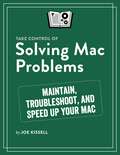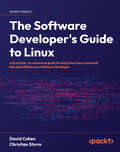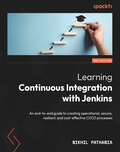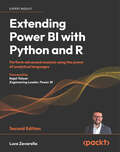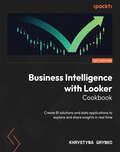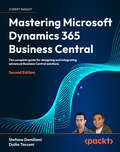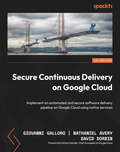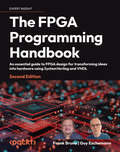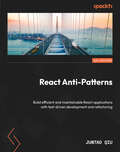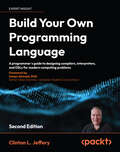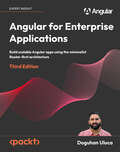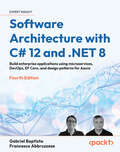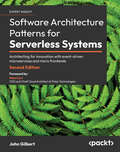- Table View
- List View
Manhattan (Carl Weber's Five Families of New York #5)
by C. N. PhillipsThe gritty tales of New York&’s five families returns for its fifth installment. Heavy is the head that wears the crown, and Caesar King feels weighted to the ground. The Five Families are in complete disarray, and Caesar realizes too late that stepping down was the wrong thing to do. It&’s up to him to make the puzzle whole again. But when another war comes to their doorsteps and a past mistake comes back for blood, death rips through the boroughs like a tornado. In the end, there might not be any pieces left to put back together.
Discovering the Social Mind: Selected works of Christopher D. Frith (World Library of Psychologists)
by Christopher D. FrithIn the World Library of Psychologists series, international experts themselves present career-long collections of what they judge to be their finest pieces - extracts from books, key articles, salient research findings, and their major practical theoretical contributions.Christopher D. Frith has an international reputation as an eminent scholar and pioneer in the fields of schizophrenia, consciousness, and social cognition. A specially written introduction gives an overview of his career and contextualises the selection in relation to changes in the field during this time.This collection reflects the various directions of Frith’s work, which has become increasingly philosophically oriented throughout his career, and enables the reader to trace major developments in these areas over the last forty years. Frith has had his work nominated for the Royal Society Science Book Award and, in 2009, was awarded the Fyssen Foundation Prize for his work on neuropsychology. He has also been awarded several prestigious prizes for his collaborative work with Uta Frith.This book is an essential read for those students and researchers engaged in the fields of social cognition, cognitive psychology and consciousness studies.
The Development of Jury Service in Japan: A square block in a round hole?
by Anna DobrovolskaiaThis book presents a comprehensive account of past and present efforts to introduce the jury system in Japan. Four legal reforms are documented and assessed: the implementation of the bureaucratic and all-judge special jury systems in the 1870s, the introduction of the all-layperson jury in the late 1920s, the transplantation of the Anglo-American-style jury system to Okinawa under the U.S. Occupation, and the implementation of the mixed-court lay judge (saiban’in) system in 2009. While being primarily interested in the related case studies, the book also discusses the instances when the idea of introducing trial by jury was rejected at different times in Japan’s history. Why does legal reform happen? What are the determinants of success and failure of a reform effort? What are the prospects of the saiban’in system to function effectively in Japan? This book offers important insights on the questions that lie at the core of the law and society debate and are highly relevant for understanding contemporary Japan and its recent and distant past.
Future Memory Practices: Across Institutions, Communities, and Modalities (Participatory Memory Practices)
by Rachel Charlotte Smith Gertraud KochFuture Memory Work addresses a crucial challenge in contemporary pluralistic societies: the organisation of open, participatory and socially inclusive memory practices in digital media ecologies. It brings a novel relational approach to future memory work across institutions, people, and modalities.Advancing inter- and transdisciplinary research and rich empirical cases from across Europe and beyond, the book examines how memory practices in digital media are open for engagement of people with diverse backgrounds. It analyses the modalities of memory making and how they can enable institutional and public memory making with a broad spectrum of people and groups in civil society at local, translocal, national and global levels. The chapters examine the mediatized character of memory making, whilst also critically considering what obstacles and potentials emerge from participatory memory work. As a whole, the book is a comprehensive source of knowledge and ideas for creating socially inclusive, sustainable memory practices and futures. It sets the multidisciplinary research agenda for advancing studies of heritage in contemporary digital media as an element and a driver of cultural and social change.Future Memory Work is essential reading for academics, students and professionals working in the fields of Anthropology, Museum Studies, Digital Cultural Heritage, Memory Studies, Cultural Studies and Design.
Gender, Power and Identity in the Early Modern House of Orange-Nassau
by Susan Broomhall Jacqueline Van GentHow do gender and power relationships affect the expression of family, House and dynastic identities? The present study explores this question using a case study of the House of Orange-Nassau, whose extensive visual, material and archival sources from both male and female members enable the authors to trace their complex attempts to express, gain and maintain power: in texts, material culture, and spaces, as well as rituals, acts and practices. The book adopts several innovative approaches to the history of the Orange-Nassau family, and to familial and dynastic studies generally. Firstly, the authors analyse in detail a vast body of previously unexplored sources, including correspondence, artwork, architectural, horticultural and textual commissions, ceremonies, practices and individual actions that have, surprisingly, received little attention to date individually, and consider these as the collective practices of a key early modern dynastic family. They investigate new avenues about the meanings and practices of family and dynasty in the early modern period, extending current research that focuses on dominant men to ask how women and subordinate men understood 'family' and 'dynasty', in what respects such notions were shared among members, and how it might have been fractured and fashioned by individual experiences. Adopting a transnational approach to the Nassau family, the authors explore the family's self-presentation across a range of languages, cultures and historiographical traditions, situating their representation of themselves as an influential House within an international context and offering a new vision of power as a gendered concept.
Evolution, Human Behaviour and Morality: The Legacy of Westermarck (Philosophy and Method in the Social Sciences)
by Olli Lagerspetz Jan Antfolk Ylva Gustafsson Camilla KronqvistThis book highlights the recent re-emergence of Edward Westermarck's work in modern approaches to morality and altruism, examining his importance as one of the founding fathers of anthropology and as a moral relativist, who identified our moral feelings with biologically-evolved retributive emotions.Questioning the extent to which current debates on the relationship between biology and morality are similar to those in which Westermarck himself was involved, the authors ask what can be learnt from his arguments and from the criticism that he encountered. Drawing on Westermarck's manuscripts and papers as well as his published work, the authors show the importance of situating debates, whether modern or classical, in their correct methodological and philosophical context.This volume is a rigorous assessment of the ways in which morality is connected with human biological nature. It plays close attention to the development of debates in this field and will appeal to scholars of sociology, anthropology and philosophy.
The Routledge Handbook of the History of Settler Colonialism (Routledge History Handbooks)
by Lorenzo Veracini Edward CavanaghThe Routledge Handbook of the History of Settler Colonialism examines the global history of settler colonialism as a distinct mode of domination from ancient times to the present day. It explores the ways in which new polities were established in freshly discovered ‘New Worlds’, and covers the history of many countries, including Australia, New Zealand, Israel, Japan, South Africa, Liberia, Algeria, Canada, and the USA.Chronologically as well as geographically wide-reaching, this volume focuses on an extensive array of topics and regions ranging from settler colonialism in the Neo-Assyrian and Roman empires, to relationships between indigenes and newcomers in New Spain and the early Mexican republic, to the settler-dominated polities of Africa during the twentieth century. Its twenty-nine inter-disciplinary chapters focus on single colonies or on regional developments that straddle the borders of present-day states, on successful settlements that would go on to become powerful settler nations, on failed settler colonies, and on the historiographies of these experiences.Taking a fundamentally international approach to the topic, this book analyses the varied experiences of settler colonialism in countries around the world. With a synthesizing yet original introduction, this is a landmark contribution to the emerging field of settler colonial studies and will be a valuable resource for anyone interested in the global history of imperialism and colonialism.
Chinese Culture Through Legends and Fiction: A Guided Reader
by Zhenjun ZhangThis is a collection of selected and translated Chinese legends and tales arranged under specific topics important to Chinese culture, with an introduction and reading guide for each piece.Comprised of 4 parts covering Confucian culture, Daoist culture, Buddhist culture and topics beyond the Three Teachings, the sources featured in this anthology include legends, fictional works, historical texts, as well as philosophical texts of ancient China, ranging from the Han 漢dynasty (206 BCE-220 CE) to the Qing 清dynasty (1644-1911).Helping readers learn about Chinese customs, traditions, and values by immersing them in the wonderful world of traditional China, with the compelling legends and tales revealing the fascinating meshwork of Chinese culture, this book is an invaluable text for students and scholars of Chinese literature, culture and history, as well as general readers with an interest in China.
Praying to Portraits: Audience, Identity, and the Inquisition in the Early Modern Hispanic World
by Adam JasienskiIn Praying to Portraits, art historian Adam Jasienski examines the history, meaning, and cultural significance of a crucial image type in the early modern Hispanic world: the sacred portrait. Across early modern Spain and Latin America, people prayed to portraits. They prayed to “true” effigies of saints, to simple portraits that were repainted as devotional objects, and even to images of living sitters depicted as holy figures. Jasienski places these difficult-to-classify image types within their historical context. He shows that rather than being harbingers of secular modernity and autonomous selfhood, portraits were privileged sites for mediating an individual’s relationship to the divine. Using Inquisition records, hagiographies, art-theoretical treatises, poems, and plays, Jasienski convincingly demonstrates that portraiture was at the very center of broader debates about the status of images in Spain and its colonies.Highly original and persuasive, Praying to Portraits profoundly revises our understanding of early modern portraiture. It will intrigue art historians across geographical boundaries, and it will also find an audience among scholars of architecture, history, and religion in the early modern Hispanic world.
Take Control of Your Passwords
by Joe KissellPassword overload has driven many of us to take dangerous shortcuts. If you think ZombieCat12 is a secure password, that you can safely reuse a password, or that no one would try to steal your password, think again! Overcome password frustration with expert advice from Joe Kissell!
Take Control of DEVONthink 3
by Joe KissellDEVONthink 3 offers a slew of features for defeating information overload, but mastering its power is easier with real-world advice from DEVONthink power user Joe Kissell. He helps you understand the best ways to put information into DEVONthink and how to organize it so you can find it later. He also covers syncing DEVONthink databases among your Apple devices and using DEVONthink To Go in iOS.
Take Control of Solving Mac Problems
by Joe KissellMacs are generally quite reliable computers, but things still can and do go wrong. When you encounter an error message, an ornery app, or other unwanted behavior, don't panic. Take a deep breath and turn to the expert advice in "Take Control of Solving Mac Problems."
The Software Developer's Guide to Linux: A practical, no-nonsense guide to using the Linux command line and utilities as a software developer
by David Cohen Christian SturmA must-read for software developers lacking command-line skills, focusing on Linux. It provides transferable command-line proficiency for use in Mac OS, Unix, and Windows with WSLKey FeaturesA practical, no-nonsense guide specifically written for developers (not sysadmins) who need to quickly learn command-line skillsExpand your practical skills and look like a wizard on the command lineBuild practical skills to work effectively with the most common CLI tools on Unix-like systemsBook DescriptionDevelopers are always looking to raise their game to the next level, yet most are completely lost when it comes to the Linux command line. This book is the bridge that will take you to the next level in your software development career. Most of the skills in the book can be immediately put to work to make you a more efficient developer. It’s written specifically for software engineers, not Linux system administrators, so each chapter will equip you with just enough theory to understand what you’re doing before diving into practical commands that you can use in your day-to-day work as a software developer. As you work through the book, you’ll quickly absorb the basics of how Linux works while you get comfortable moving around the command line. Once you’ve got the core skills, you’ll see how to apply them in different contexts that you’ll come across as a software developer: building and working with Docker images, automating boring build tasks with shell scripts, and troubleshooting issues in production environments. By the end of the book, you’ll be able to use Linux and the command line comfortably and apply your newfound skills in your day-to-day work to save time, troubleshoot issues, and be the command-line wizard that your team turns to.What you will learnLearn useful command-line tricks and tools that make software development, testing, and troubleshooting easyUnderstand how Linux and command line environments actually workCreate powerful, customized tools and save thousands of lines of code with developer-centric Linux utilitiesGain hands-on experience with Docker, SSH, and Shell scripting tasks that make you a more effective developerGet comfortable searching logs and troubleshooting problems on Linux serversHandle common command-line situations that stump other developersWho this book is forThis book is for software developers who want to build practical Command-Line (CLI) and Linux skills and who want to quickly fill the gap to advance their skills and their career. Basic knowledge of editing text, working with files and folders, having some idea of what “operating systems” are, installing software, and using a development environment is assumed.
Learning Continuous Integration with Jenkins: An end-to-end guide to creating operational, secure, resilient, and cost-effective CI/CD processes
by Nikhil PathaniaIntegrate Jenkins, Kubernetes, and more on cloud into a robust, GitOps-driven CI/CD system, leveraging JCasC, IaC, and AI for a streamlined software delivery processKey FeaturesFollow the construction of a Jenkins CI/CD pipeline start to finish through a real-world exampleConstruct a continuous deployment (CD) pipeline in Jenkins using GitOps principles and integration with Argo CDCraft and optimize your CI pipeline code with ChatGPT and GitHub CopilotPurchase of the print or Kindle book includes a free PDF eBookBook DescriptionThis updated edition of Learning Continuous Integration with Jenkins is your one-stop guide to implementing CI/CD with Jenkins, addressing crucial technologies such as cloud computing, containerization, Infrastructure as Code, and GitOps. Tailored to both beginners and seasoned developers, the book provides a practical path to mastering a production-grade, secure, resilient, and cost-effective CI/CD setup. Starting with a detailed introduction to the fundamental principles of CI, this book systematically takes you through setting up a CI environment using Jenkins and other pivotal DevOps tools within the CI/CD ecosystem. You’ll learn to write pipeline code with AI assistance and craft your own CI pipeline. With the help of hands-on tutorials, you’ll gain a profound understanding of the CI process and Jenkins’ robust capabilities. Additionally, the book teaches you how to expand your CI pipeline with automated testing and deployment, setting the stage for continuous deployment. To help you through the complete software delivery process, this book also covers methods to ensure that your CI/CD setup is maintainable across teams, secure, and performs optimally. By the end of the book, you’ll have become an expert in implementing and optimizing CI/CD setups across diverse teams.What you will learnUnderstand CI with the Golden Circle theoryDeploy Jenkins on the cloud using Helm charts and Jenkins Configuration as Code (JCasC)Implement optimal security practices to ensure Jenkins operates securelyExtend Jenkins for CI by integrating with SonarQube, GitHub, and ArtifactoryScale Jenkins using containers and the cloud for optimal performanceMaster Jenkins declarative syntax to enrich your pipeline coding vocabularyEnhance security and improve pipeline code within your CI/CD process using best practicesWho this book is forThis book is for a diverse audience, from university students studying Agile software development to seasoned developers, testers, release engineers, and project managers. If you’re already using Jenkins for CI, this book will assist you in elevating your projects to CD. Whether you’re new to the concepts of Agile, CI, and CD, or a DevOps engineer seeking advanced insights into JCasC, IaC, and Azure, this book will equip you with the tools to harness Jenkins for improved productivity and streamlined deliveries in the cloud.
Azure Data Factory Cookbook: Build ETL, Hybrid ETL, and ELT pipelines using ADF, Synapse Analytics, Fabric and Databricks
by Dmitry Foshin Tonya Chernyshova Dmitry Anoshin Xenia IretonData Engineers guide to solve real-world problems encountered while building and transforming data pipelines using Azure's data integration toolKey FeaturesSolve real-world data problems and create data-driven workflows with ease using Azure Data FactoryBuild an ADF pipeline that operates on pre-built ML model and Azure AIGet up and running with Fabric Data Explorer and extend ADF with Logic Apps and Azure functionsBook DescriptionThis new edition of the Azure Data Factory book, fully updated to reflect ADS V2, will help you get up and running by showing you how to create and execute your first job in ADF. There are updated and new recipes throughout the book based on developments happening in Azure Synapse, Deployment with Azure DevOps, and Azure Purview. The current edition also runs you through Fabric Data Factory, Data Explorer, and some industry-grade best practices with specific chapters on each. You’ll learn how to branch and chain activities, create custom activities, and schedule pipelines, as well as discover the benefits of cloud data warehousing, Azure Synapse Analytics, and Azure Data Lake Gen2 Storage. With practical recipes, you’ll learn how to actively engage with analytical tools from Azure Data Services and leverage your on-premises infrastructure with cloud-native tools to get relevant business insights. You'll familiarize yourself with the common errors that you may encounter while working with ADF and find out the solutions to them. You’ll also understand error messages and resolve problems in connectors and data flows with the debugging capabilities of ADF. By the end of this book, you’ll be able to use ADF with its latest advancements as the main ETL and orchestration tool for your data warehouse projects.What you will learnBuild and Manage data pipelines with ease using the latest version of ADFConfigure, load data, and operate data flows with Azure SynapseGet up and running with Fabric Data FactoryWorking with Azure Data Factory and Azure PurviewCreate big data pipelines using Databricks and Delta tablesIntegrate ADF with commonly used Azure services such as Azure ML, Azure Logic Apps, and Azure FunctionsLearn industry-grade best practices for using Azure Data FactoryWho this book is forThis book is for ETL developers, data warehouse and ETL architects, software professionals, and anyone else who wants to learn about the common and not-so-common challenges faced while developing traditional and hybrid ETL solutions using Microsoft's Azure Data Factory. You’ll also find this book useful if you are looking for recipes to improve or enhance your existing ETL pipelines. Basic knowledge of data warehousing is a prerequisite.
Extending Power BI with Python and R: Perform advanced analysis using the power of analytical languages
by Luca ZavarellaIngest, transform, manipulate, and visualize your data beyond Power BI's capabilities. Purchase of the print or Kindle book includes a free eBook in PDF format.Key FeaturesDiscover best practices for using Python and R in Power BI by implementing non-trivial codeEnrich your Power BI dashboards using external APIs and machine learning modelsCreate any visualization, as complex as you want, using Python and R scriptsBook DescriptionThe latest edition of this book delves deep into advanced analytics, focusing on enhancing Python and R proficiency within Power BI. New chapters cover optimizing Python and R settings, utilizing Intel's Math Kernel Library (MKL) for performance boosts, and addressing integration challenges. Techniques for managing large datasets beyond available RAM, employing the Parquet data format, and advanced fuzzy matching algorithms are explored. Additionally, it discusses leveraging SQL Server Language Extensions to overcome traditional Python and R limitations in Power BI. It also helps in crafting sophisticated visualizations using the Grammar of Graphics in both R and Python. This Power BI book will help you master data validation with regular expressions, import data from diverse sources, and apply advanced algorithms for transformation. You'll learn how to safeguard personal data in Power BI with techniques like pseudonymization, anonymization, and data masking. You'll also get to grips with the key statistical features of datasets by plotting multiple visual graphs in the process of building a machine learning model. The book will guide you on utilizing external APIs for enrichment, enhancing I/O performance, and leveraging Python and R for analysis. You'll reinforce your learning with questions at the end of each chapter.What you will learnConfigure optimal integration of Python and R with Power BIPerform complex data manipulations not possible by default in Power BIBoost Power BI logging and loading large datasetsExtract insights from your data using algorithms like linear optimizationCalculate string distances and learn how to use them for probabilistic fuzzy matchingHandle outliers and missing values for multivariate and time-series dataApply Exploratory Data Analysis in Power BI with RLearn to use Grammar of Graphics in PythonWho this book is forThis book is for business analysts, business intelligence professionals, and data scientists who already use Microsoft Power BI and want to add more value to their analysis using Python and R. Working knowledge of Power BI is required to make the most of this book. Basic knowledge of Python and R will also be helpful.
Business Intelligence with Looker Cookbook: Create BI solutions and data applications to explore and share insights in real time
by Khrystyna GrynkoUse Looker for visualizing data, data analysis, and reporting, and learn how to connect to your data, build dashboards and reports, and share insights with your teamKey FeaturesExplore data visualization, analysis, and reporting with Looker to gain insights from your dataConnect to data sources, build dashboards, and create reports to track and share key metricsShare insights with your team to make better business decisionsPurchase of the print or Kindle book includes a free PDF eBookBook DescriptionLooker is a data analytics and business intelligence platform that allows organizations to explore, analyze, and visualize their data. It provides tools for data modeling, exploration, and visualization, enabling you to gain insights from your data to make informed business decisions. You’ll start with the basics, from setting up your Looker environments to configuring views and models using LookML. As you progress, you’ll delve into more advanced topics, such as navigating data in Explore, tailoring dashboards to your needs, and adding dynamic elements for interactivity. Along the way, you'll gain invaluable troubleshooting skills to tackle common issues and optimize your Looker usage, ensuring a smooth and seamless experience. Furthermore, the book extends your understanding beyond the basics, equipping you with the knowledge you need to develop Looker applications and seamlessly integrate them with other tools and applications. You'll also explore advanced techniques for harnessing Looker's full potential, empowering you to establish data-driven decision-making and innovation within your organization. By the end of this BI book, you'll have gained a solid understanding of how to use Looker to find important information, make tasks easier, and derive important insights.What you will learnUnderstand Looker's key components, including LookML, data models, and dashboards.Explore Looker's functionality, including custom fields, calculations, and visualizations.Work with Looker dashboards using dynamic elements like links and actions.Use different types of filters for dimensions to create dashboardsDevelop Looker applications using essential tools and frameworksExplore additional applications for the Looker organizationIntegrate Looker with other tools using APIs, connectors, and data pipelinesWho this book is forIf you’re a business analyst, data analyst, or BI developer who wants to get well-versed with the features of Looker, this book is for you. Basic knowledge of business intelligence is required to get started.
Mastering Microsoft Dynamics 365 Business Central: The complete guide for designing and integrating advanced Business Central solutions
by Stefano Demiliani Duilio TacconiUtilize Microsoft Dynamics 365 Business Central's most recent capabilities to create bespoke business management solutions using best practices learned along the way from veterans in the industry. Purchase of the print or Kindle book includes a free PDF eBookKey FeaturesExtend Business Central's functionalities through Azure, Power Platform, GitHub, and custom extensionsUnlock the potential of data exchange and functionality expansion by integrating with external systems using APIs and ODataBuild reliable, maintainable, and continuously improving solutions while writing performant, well-structured code and using telemetries and DevOpsBook DescriptionThis book dives straight into guiding you through the process of building real-world solutions with the AL language and Visual Studio Code. It emphasizes best practices and extensibility patterns to ensure your extensions are well-structured, maintainable, and meet the needs of modern businesses. You'll learn advanced AL techniques, report creation methods, debugging strategies, and how to leverage telemetries for monitoring. Additionally, it covers performance optimization practices and API integration to help you create efficient and interconnected solutions. With a focus on extension development, this new edition allows you to jump right into coding without spending time on setup processes. This book introduces new chapters covering essential tasks that Business Central developers frequently encounter, such as file handling and printing management. Finally, the book expands its scope by including chapters on various integration aspects, including VS Code extensions, GitHub DevOps, Azure services, and Power Platform integrations. We’ll wrap up by covering Copilot capabilities in Business Central and how you can create your own generative AI copilots. By mastering these concepts and techniques, you'll be well-equipped to create powerful and customized solutions that extend the capabilities of Dynamics 365 Business Central.What you will learnDeveloping a customized solution for Dynamics 365 Business CentralWriting performant code following extensibility patternsHandling reporting, files, and printing on a cloud environmentHandling Business Central telemetries with AzureWriting APIs and integrations for Dynamics 365 Business CentralApplying DevOps and CI/CD to development projects by using GitHubIntegrating Business Central with Power PlatformPublishing your solutions to AppSource marketplaceManage Copilot capabilities and create your own generative AI copilotWho this book is forThis book is intended for new developers who want to get started with Dynamics 365 Business Central. Professionals with expertise will also benefit from this book by enhancing their knowledge and comprehension of Dynamics 365 Business Central development platform and best practices
Secure Continuous Delivery on Google Cloud: Implement an automated and secure software delivery pipeline on Google Cloud using native services
by Giovanni Galloro Nathaniel Avery David DorbinBuild an end-to-end continuous delivery pipeline on Google Cloud and secure your software supply chain using GCP tools and services including Cloud Code, Cloud Workstations, Cloud Build, Artifact Registry, and Cloud DeployKey FeaturesGain hands-on experience building an end-to-end software delivery pipeline using Google Cloud servicesDeploy your applications on GKE, Cloud Run, and across hybrid and multi-cloud environmentsSecure pipelines with artifact scanning, dependency vulnerability checks, signed provenance, and admission controlPurchase of the print or Kindle book includes a free PDF eBookBook DescriptionContinuous delivery, a cornerstone of modern software engineering, facilitates quick and secure software delivery using a robust toolkit encompassing automated builds, testing, source code management, artifact storage, and deployment. Whether you integrate tools from different providers or use a set of managed services from a single cloud provider, the goal is to streamline setup, integration, and management. This book focuses on continuous delivery on Google Cloud. Starting with an introduction to continuous delivery and secure software supply chain concepts, this book uses hands-on exercises to demonstrate how to continuously test your application with Skaffold and Cloud Code, leverage AI-assisted code generation with Cloud Code and Cloud Workstations, and automate your continuous integration with Cloud Build. You’ll see how to store and scan your software artifacts on Artifact Registry, orchestrate deployments with Cloud Deploy, and release your software on GKE and Cloud Run, configured to admit only trusted code. Using an example application, you’ll implement tools for creating an end-to-end delivery pipeline using Google Cloud services. By the end of this book, you’ll be able to build a secure software delivery pipeline from development to production using Google Cloud managed services and best practices.What you will learnCreate an end-to-end continuous delivery pipeline using Cloud Build, Artifact Registry, and Cloud DeployDevelop, build, and deploy container-based applications with Skaffold and Cloud CodeExperiment with AI-assisted code generation in Cloud CodeAutomate continuous integration with Cloud Build triggersAutomate deployment on GKE and Cloud Run through Cloud DeployEnhance pipeline security with Artifact Analysis, Binary Authorization, and SLSAApply best practices, including logging and monitoringWho this book is forThis book is for DevOps, Platform, and Cloud Engineers tasked with managing application deployment and creating continuous delivery pipelines who want to automate workflows in a fully managed, scalable, and secure platform. Software developers involved in application delivery and interested in harnessing Google Cloud tools to optimize development flow status and feedback loop will also find this book useful. Prior knowledge of Google Cloud fundamentals (including Cloud APIs and IAM), software delivery, containerization, and Kubernetes will enhance the reading experience.
The FPGA Programming Handbook: An essential guide to FPGA design for transforming ideas into hardware using SystemVerilog and VHDL
by Frank Bruno Guy EschemannDevelop solid FPGA programming skills in SystemVerilog and VHDL by crafting practical projects – VGA controller, microprocessor, calculator, keyboard – and amplify your know-how with insider industry knowledge, all in one handbook. Purchase of the print or Kindle book includes a free eBook in PDF formatKey FeaturesExplore a wide range of FPGA applications, grasp their versatility, and master Xilinx FPGA tool flowMaster the intricacies of SystemVerilog and VHDL to develop robust and efficient hardware circuitsRefine skills with CPU, VGA, and calculator projects for practical expertise in real-world applicationsBook DescriptionIn today's tech-driven world, Field Programmable Gate Arrays (FPGAs) are foundation of many modern systems. Transforming ideas into reality demands a deep dive into FPGA architecture, tools, and design principles. This FPGA book is your essential companion to FPGA development with SystemVerilog and VHDL, tailored for both beginners and those looking to expand their knowledge. In this edition, you will gain versatility in FPGA design, opening doors to diverse opportunities and projects in the field. Go beyond theory with structured, hands-on projects, starting from simple LED control and progressing to advanced microcontroller applications, highly sought after in today's FPGA job market. You will go from basic Boolean logic circuits to a resource-optimized calculator, showcasing your hardware design prowess. Elevate your knowledge by designing a VGA controller, demonstrating your ability to synthesize complex hardware systems. Use this handbook as your FPGA development guide, mastering intricacies, igniting creativity, and emerging with the expertise to craft hardware circuits using SystemVerilog and VHDL. This isn't just another technical manual; it's your exhilarating journey to master both theory and practice, accelerating your FPGA design skills to soaring new heights. Grab your copy today and start this exciting journey!What you will learnUnderstand the FPGA architecture and its implementationGet to grips with writing SystemVerilog and VHDL RTLMake FPGA projects using SystemVerilog and VHDL programmingWork with computer math basics, parallelism, and pipeliningExplore the advanced topics of AXI and keyboard interfacing with PS/2Discover how you can implement a VGA interface in your projectsExplore the PMOD connectors-SPI and UART, using Nexys A7 boardImplement an embedded microcontroller in the FPGAWho this book is forThis FPGA design book is for embedded system developers, engineers, and programmers who want to learn FPGA design using SystemVerilog or VHDL programming from scratch. FPGA designers looking to gain hands-on experience with real-world projects will also find this book useful. Whether you are new to FPGA development or seeking to enhance your skills, this book provides a solid foundation and practical experience in FPGA design.
React Anti-Patterns: Build efficient and maintainable React applications with test-driven development and refactoring
by Juntao QiuMaster efficient coding practices, address common anti-patterns, and construct scalable React apps with practical insights and techniquesKey FeaturesIdentify and address React anti-patterns while learning testing strategies and refactoring techniques for efficient codebasesExplore data modelling, design patterns, and state management in ReactEnhance code quality, maintainability, and scalability in React applicationsPurchase of the print or Kindle book includes a free PDF eBookBook DescriptionTake your React development skills to the next level by examining common anti-patterns with expert insights and practical solutions, to refine your codebases into sophisticated and scalable creations. Through this easy-to-follow guide, React Anti-Patterns serves as a roadmap to elevating the efficiency and maintainability of your React projects. You’ll begin by familiarizing yourself with the essential aspects of React before exploring strategies for structuring React applications and creating well-organized, modular, and easy-to-maintain codebases. From identifying and addressing common anti-patterns using refactoring techniques to harnessing the power of test-driven development (TDD), you’ll learn about the tools and techniques necessary to create reliable and robust tests. As you advance, you’ll get to grips with business logic and design patterns that offer solutions to prevalent challenges faced in React development. The book also offers insights into using composition patterns, such as code splitting and multiple entry points, to enhance the flexibility and modularity of your React applications, guiding you through end-to-end project implementation. By the end of this React book, you’ll be able to overcome common challenges and pitfalls to transform your React projects into elegant, efficient, and maintainable codebases.What you will learnFormulate comprehensive testing strategies and leverage testing framework capabilitiesImplement TDD practices to drive the development process and elevate code quality, especially in extensive React projectsUse design patterns effectively to create scalable and reusable React componentsApply established software design principles to craft resilient applications within ReactAchieve modularity and loose coupling in React codebases by mastering the separation of concernsEnsure clean code by adhering to software design best practices in React developmentWho this book is forThis book is for React developers of all skill levels who share a passion for crafting efficient and maintainable codebases. Whether you're a beginner who wants to establish a solid foundation or an experienced developer looking to refine your skills, this guide offers invaluable insights, practical solutions, and real-world examples to enable you to excel at building scalable, elegant, and high-performing React applications.
Build Your Own Programming Language: A programmer's guide to designing compilers, interpreters, and DSLs for modern computing problems
by Clinton L. JefferyLearn to design your own programming language in a hands-on way by building compilers, using preprocessors, transpilers, and more, in this fully-refreshed second edition, written by the creator of the Unicon programming language. Purchase of the print or Kindle book includes a free PDF eBookKey FeaturesTakes a hands-on approach; learn by building the Jzero language, a subset of Java, with example code shown in both the Java and Unicon languagesLearn how to create parsers, code generators, scanners, and interpretersTarget bytecode, native code, and preprocess or transpile code into a high-level languageBook DescriptionThere are many reasons to build a programming language: out of necessity, as a learning exercise, or just for fun. Whatever your reasons, this book gives you the tools to succeed. You’ll build the frontend of a compiler for your language and generate a lexical analyzer and parser using Lex and YACC tools. Then you’ll explore a series of syntax tree traversals before looking at code generation for a bytecode virtual machine or native code. In this edition, a new chapter has been added to assist you in comprehending the nuances and distinctions between preprocessors and transpilers. Code examples have been modernized, expanded, and rigorously tested, and all content has undergone thorough refreshing. You’ll learn to implement code generation techniques using practical examples, including the Unicon Preprocessor and transpiling Jzero code to Unicon. You'll move to domain-specific language features and learn to create them as built-in operators and functions. You’ll also cover garbage collection. Dr. Jeffery’s experiences building the Unicon language are used to add context to the concepts, and relevant examples are provided in both Unicon and Java so that you can follow along in your language of choice. By the end of this book, you'll be able to build and deploy your own domain-specific language.What you will learnAnalyze requirements for your language and design syntax and semantics.Write grammar rules for common expressions and control structures.Build a scanner to read source code and generate a parser to check syntax.Implement syntax-coloring for your code in IDEs like VS Code.Write tree traversals and insert information into the syntax tree.Implement a bytecode interpreter and run bytecode from your compiler.Write native code and run it after assembling and linking using system tools.Preprocess and transpile code into another high-level languageWho this book is forThis book is for software developers interested in the idea of inventing their own language or developing a domain-specific language. Computer science students taking compiler design or construction courses will also find this book highly useful as a practical guide to language implementation to supplement more theoretical textbooks. Intermediate or better proficiency in Java or C++ programming languages (or another high-level programming language) is assumed.
Angular for Enterprise Applications: Build scalable Angular apps using the minimalist Router-first architecture
by Doguhan UlucaHarness the full power of Angular 17 with up-to-date tools and enterprise-level best practices Purchase of the print or Kindle book includes a free PDF eBookKey FeaturesDive straight into the most relevant topics that will help you build large, complex, and high-performance web applicationsFind updated examples, projects, and an overview of the latest tools and updates – including Jest, Cypress, NgRx workspace, Apollo GraphQL, and Angular Dev ToolsGet to grips with reactive code and learn how to resolve potential issues before they crop upBook DescriptionIf you’re looking to upskill and build sophisticated, minimalist web applications suited for enterprise use, Angular for Enterprise Applications is your guide to the next level of engineering mastery. In its third edition, this Angular book distils hard-earned lessons into a lucid roadmap for success. Adopting a pragmatic approach founded on a robust technical base, you'll utilize both JavaScript and TypeScript fundamentals. You'll also embrace agile engineering coding principles and learn to architect optimally sized enterprise solutions employing the freshest concepts in Angular. You’ll gradually build upon this foundation through insightful recipes, sample apps, and crystal-clear explanations. You’ll master authentication and authorization and achieve optimal performance through reactive programming and lazy loading, build complex yet flexible UIs with Router-first principles, and then integrate with backend systems using REST and GraphQL APIs. You’ll cover modern tools like RxAngular, Qwik, and Signals. You’ll construct master/detail views using data tables and NgRx for state management. You’ll explore DevOps using Docker and build CI/CD pipelines necessary for high-performance teams. By the end of this book, you’ll be proficient in leveraging Angular in enterprise and design robust systems that scale effortlessly.What you will learnBest practices for architecting and leading enterprise projectsMinimalist, value-first approach to delivering web appsHow standalone components, services, providers, modules, lazy loading, and directives work in AngularManage your app's data reactivity using Signals or RxJSState management for your Angular apps with NgRxAngular ecosystem to build and deliver enterprise applicationsAutomated testing and CI/CD to deliver high quality appsAuthentication and authorizationBuilding role-based access control with REST and GraphQLWho this book is forThis book is for mid-to-senior developers looking to gain mastery by learning how to write, test, and deploy Angular in an enterprise environment. Working experience with JavaScript is a prerequisite, and a familiarity with TypeScript and RESTful APIs will help you understand the topics covered in this book more effectively
Software Architecture with C# 12 and .NET 8: Build enterprise applications using microservices, DevOps, EF Core, and design patterns for Azure
by Gabriel Baptista Francesco AbbruzzeseA book for the aspiring .NET software architect – design scalable and high-performance enterprise solutions using the latest features of C# 12 and .NET 8 Purchase of the print or Kindle book includes a free PDF eBookKey FeaturesGet introduced to software architecture fundamentals and begin applying them in .NETExplore the main technologies used by software architects and choose the best ones for your needsMaster new developments in .NET with the help of a practical case study that looks at software architecture for a travel agencyBook DescriptionSoftware Architecture with C# 12 and .NET 8 puts high-level design theory to work in a .NET context, teaching you the key skills, technologies, and best practices required to become an effective .NET software architect. This fourth edition puts emphasis on a case study that will bring your skills to life. You’ll learn how to choose between different architectures and technologies at each level of the stack. You’ll take an even closer look at Blazor and explore OpenTelemetry for observability, as well as a more practical dive into preparing .NET microservices for Kubernetes integration. Divided into three parts, this book starts with the fundamentals of software architecture, covering C# best practices, software domains, design patterns, DevOps principles for CI/CD, and more. The second part focuses on the technologies, from choosing data storage in the cloud to implementing frontend microservices and working with Serverless. You’ll learn about the main communication technologies used in microservices, such as REST API, gRPC, Azure Service Bus, and RabbitMQ. The final part takes you through a real-world case study where you’ll create software architecture for a travel agency. By the end of this book, you will be able to transform user requirements into technical needs and deliver highly scalable enterprise software architectures.What you will learnProgram and maintain Azure DevOps and explore GitHub ProjectsManage software requirements to design functional and non-functional needsApply architectural approaches such as layered architecture and domain-driven designMake effective choices between cloud-based and data storage solutionsImplement resilient frontend microservices, worker microservices, and distributed transactionsUnderstand when to use test-driven development (TDD) and alternative approachesChoose the best option for cloud development, from IaaS to ServerlessWho this book is forThis book is for engineers and senior software developers aspiring to become architects or looking to build enterprise applications with the .NET stack. Basic familiarity with C# and .NET is required to get the most out of this software architecture book.
Software Architecture Patterns for Serverless Systems: Architecting for innovation with event-driven microservices and micro frontends
by John GilbertDelve into the second edition to master serverless proficiency and explore new chapters on security techniques, multi-regional deployment, and optimizing observability.Key FeaturesGain insights from a seasoned CTO on best practices for designing enterprise-grade software systemsDeepen your understanding of system reliability, maintainability, observability, and scalability with real-world examplesElevate your skills with software design patterns and architectural concepts, including securing in-depth and running in multiple regionsBook DescriptionOrganizations undergoing digital transformation rely on IT professionals to design systems to keep up with the rate of change while maintaining stability. With this edition, enriched with more real-world examples, you’ll be perfectly equipped to architect the future for unparalleled innovation. This book guides through the architectural patterns that power enterprise-grade software systems while exploring key architectural elements (such as events-driven microservices, and micro frontends) and learning how to implement anti-fragile systems. First, you'll divide up a system and define boundaries so that your teams can work autonomously and accelerate innovation. You'll cover the low-level event and data patterns that support the entire architecture while getting up and running with the different autonomous service design patterns. This edition is tailored with several new topics on security, observability, and multi-regional deployment. It focuses on best practices for security, reliability, testability, observability, and performance. You'll be exploring the methodologies of continuous experimentation, deployment, and delivery before delving into some final thoughts on how to start making progress. By the end of this book, you'll be able to architect your own event-driven, serverless systems that are ready to adapt and change.What you will learnExplore architectural patterns to create anti-fragile systemsFocus on DevSecOps practices that empower self-sufficient, full-stack teamsApply microservices principles to the frontendDiscover how SOLID principles apply to software and database architectureGain practical skills in deploying, securing, and optimizing serverless architecturesDeploy a multi-regional system and explore the strangler pattern for migrating legacy systemsMaster techniques for collecting and utilizing metrics, including RUM, Synthetics, and Anomaly detectionWho this book is forThis book is for software architects who want to learn more about different software design patterns and best practices. This isn't a beginner's manual – you'll need an intermediate level of programming proficiency and software design experience to get started.You'll get the most out of this software design book if you already know the basics of the cloud, but it isn't a prerequisite.
